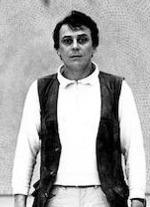
Günther Uecker
Günther Uecker, a multifaceted German artist, gained recognition as a prominent figure in the ZERO group. Uecker's artistic repertoire spans painting, object art, installations, stage designs, and films. Influenced by the avant-garde movements of Eastern Europe during the 1920s and 1930s, he also draws inspiration from Asian cultures and their philosophical concepts.
Biography of Günther Uecker
Born in Wendorf, Mecklenburg, on March 13, 1930, Günther Uecker initiated his artistic journey with painting studies at the Kunsthochschule Berlin Weissensee from 1949 to 1953. This was followed by further training at the Kunstakademie Düsseldorf apprenticed under Otto Pankok from 1955 to 1958.
In the 1950s, Günther Uecker developed a deep interest in meditative practices and purification rituals, drawing inspiration from Buddhism, Taoism, and Islam. This led him to develop his own rituals, such as repetitively hammering nails, which became a central motif in his work.
In 1960, Günther Uecker joined the ZERO group alongside Heinz Mack and Otto Piene. Uecker, Mack, and Piene collaborated, establishing shared studios at the Stedelijk Museum in Amsterdam by 1962. They notably curated a "Salon de Lumière" at the Palais des Beaux-Arts in Paris, followed by similar "light salons" in Krefeld and Frankfurt.
From 1974 to 1995, Uecker served as a professor at the Kunstakademie Düsseldorf, where he attained the rank of professor in 1976.
In 2008, along with Otto Piene, Heinz Mack, and Mattijs Visser, Uecker co-founded the international ZERO foundation. This institution houses comprehensive ZERO archives from the three artists based in Düsseldorf, along with documents and photographs from other related artists, preserving and promoting the legacy of the ZERO movement.
The artist resides and continues to create in Düsseldorf.
Exhibitions and Recognitions of Günther Uecker
Günther Uecker's debut solo exhibition in the United States was hosted at the Howard Wise Gallery on West 57th Street, showcasing notable works like the kinetic piece "New York Dancer I" (1966). Uecker also designed the set for Richard Wagner's "Lohengrin" at Bayreuth (1979–82).
A significant pinnacle of Uecker's artistic career occurred in 2000 with his design of the prayer room for the reconstructed Reichstag building in Berlin.
In early 2021, Uecker returned to the spotlight with his solo exhibition titled "Lichtbogen," held at the Lévy Gorvy Gallery in Paris. This exhibition featured a new series of artworks inspired by his experiences visiting an island in the Straits of Ormuz.
In addition to numerous exhibitions with ZERO, Uecker has been featured in prominent international shows, including documenta 4 in Kassel, Germany (1968), the Venice Biennale (1970), and a series of solo exhibitions.
The artist has garnered numerous prestigious awards throughout his career. These include the Goslarer Kaiserring in 1983, induction into the German Pour le Mérite order for Sciences and Arts in 2000, and the Berliner Bär, B.Z. Kulturpreis in Berlin in 2005, the Great Federal Cross of Merit from the Federal Republic of Germany in 2006, the Jan-Willem-Ring from Düsseldorf in 2010, and the Staatspreis des Landes Nordrhein-Westfalen in 2015.
The Art Style of Günther Uecker
With the ZERO group, Günther Uecker pioneered a new era in art distinct from German Informel. The artist focused on exploring light as a medium and delved into optical phenomena, structured series, and oscillatory realms that engaged viewers through kinetic or manual interaction.
In the early 1960s, Uecker began hammering nails into various objects such as furniture, musical instruments, and household items. Over time, he integrated nails with themes of light, developing series like light nails and kinetic nails.
Since the dissolution of the ZERO in 1966, following their final joint exhibition, Uecker has increasingly employed nails as a central artistic medium — a material that remains pivotal in his body of work to this day. One notable work, "a-x Zero Garden" from 1966, housed at the Honolulu Museum of Art, exemplifies his use of nails to create dynamic illusions of movement.
In addition to nails, Uecker incorporates materials like monochromatic paint, ash, sand, stone, glass, string, cloth, posts, and tree trunks in his art. Through these elemental materials, he imbues his creations with a poetic balance of order and chaos, creation and destruction.
Years:
Born in 1930
Country:
Germany, Wendorf, Mecklenburg
Gallery: